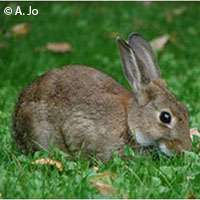Shrinking rabbit population poses threat for carnivore species

The survival of many carnivore species, including the Iberian lynx and fox, is contingent on them getting their key prey: the rabbit (Oryctolagus cuniculus). But a Spanish-Argentinean team of researchers has investigated how the collapse of the rabbit population in the late 1980s, triggered by viral haemorrhagic disease (VHD), has adversely impacted the lives of certain carnivores in Doñana National Park, a national park and wildlife refuge in south-western Spain. The findings, published in the journal Basic and Applied Ecology, indicate that the population decline for the most part has affected the lynx; this medium-sized wildcat cannot hunt other prey.
In total, the researchers assessed the diet of five species: the Iberian lynx (Lynx pardinus), fox (Vulpes vulpes), Egyptian mongoose (Herpestes ichneumon); genet (Genetta genetta), and badger (Meles meles).
"All the carnivores reduced their consumption of rabbits following the arrival of VHD," the Scientific Information and News Service (SINC) quotes Pablo Ferreras as saying. The scientist is a member of the Research Institute on Cynegetic Resources (IREC), a joint centre of the University of Castilla-La Mancha in Spain, the United States-based Center for Strategic and International Studies (CSIS), and the regional government of Castilla-La Mancha.
The data show that the biggest drops in rabbit consumption were observed among the badger and fox, down from 71.8 % to 26.2 %, and 20.2 % to 9.8 % respectively.
The species that modified its diet the most, in order to support its hunt despite the rabbit population decline, was the fox. This carnivore substituted rabbits for ungulates (in the form of carrion), birds and small mammals.
"The fox displayed a numerical response to the reduction in rabbits, declining in abundance during the five years following the arrival of VHD," says lead author Dr. Ferreras. Conversely, the genet and Egyptian mongoose more or less maintained their consumption of rabbits, thus sustaining their population numbers.
The Iberian lynx could not change its prey, according to the researchers. Dr. Ferreras points out that despite the rabbit number density being the lowest ever recorded in this area, the Iberian lynx "hardly reduced its consumption of rabbits, which continued to form the basis of 75 % of its diet." The Iberian lynx is "by necessity a rabbit specialist," he remarks.
The researchers say the social system of this wildcat changed upon the arrival of the rabbit disease. Not only did the creatures become less territorial, but the size of the females' home ranges expanded. The sub-adults stayed in the areas they had been born in.
They point out that the critical situation of the Iberian lynx, which experts say is one of the most highly endangered felines worldwide, "was made even worse, if this is possible, by its inability to hunt non-rabbit prey." Its social system also took a blow in the first year of the rabbit population collapse because the juvenile animals failed to disperse, effectively giving local density a boost.
Based on the findings, most rabbit populations in the Iberian Peninsula still feel the aftershocks from the collapse triggered by the illness. They say predation could be affecting the recovery, with rabbits having entered a low-density population balance regulated by predation. The shortage of rabbits could 'seriously' jeopardize specialist predators like the lynx.
The researchers believe management measures are needed to boost the rabbit number density, suggesting habitat improvement or restocking programs as options.
More information: Ferreras, P., et al. (2011) 'Short-term responses of mammalian carnivores to a sudden collapse of rabbits in Mediterranean Spain'. Basic and Applied Ecology, 12: 116-124. DOI: 10.1016/j.baae.2011.01.005
Provided by CORDIS
















